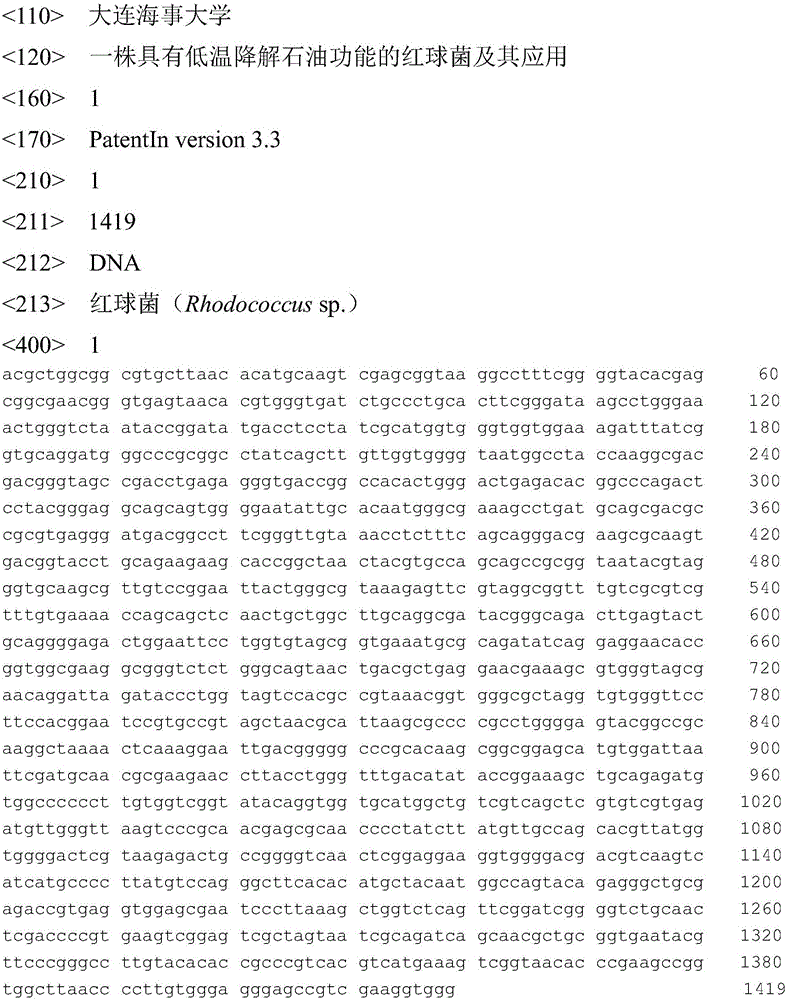Rhodococcus sp.QY-2 having low-temperature petroleum degrading function and application thereof
A technology of rhodococcus and petroleum, applied in the field of microorganisms, can solve the problems of ecological system hazards, slow evaporation of short-chain petroleum hydrocarbons, increase the difficulty of oil spill emergency and ecological restoration work, and achieve simple cultivation methods and petroleum hydrocarbon degradation capabilities strong effect
- Summary
- Abstract
- Description
- Claims
- Application Information
AI Technical Summary
Problems solved by technology
Method used
Image
Examples
Embodiment 1
[0019] Example 1 Isolation and identification of strain Rhodococcus sp.QY-2
[0020] 1. Isolation of strain Rhodococcus sp.QY-2
[0021] (1) Sample collection: On November 22, 2013, the oil pipeline of the Weifang Branch of Sinopec Oil Transportation, Storage and Transportation Company ruptured, and some crude oil polluted the waters near Jiaozhou Bay. One week after the oil spill, take the seawater contaminated by crude oil on the surface;
[0022] (2) Enrichment acclimation: add 100 mL of MMC medium to a 250 mL conical flask, sterilize at 120° C. for 15 min, and add 5 mL of collected seawater samples and 0.5 mL of sterilized crude oil. Put the mixture into a biochemical incubator, and shake it at 150 r / min and 10 °C for 30 days; after the incubation, take 5 mL of the culture solution for the next round of transfer culture: add 5 mL of the culture solution to the sterilized crude oil containing 0.5 mL. In 100 mL of MMC medium, cultured at 150 r / min for 30 d. The above step...
Embodiment 2
[0027] Example 2 Fermentation of strain Rhodococcus sp.QY-2
[0028] Pick the purified fungus with a sterile inoculating loop and put it into a conical flask containing 100 mL of sterilized 2216E liquid medium, and shake it at low temperature for 7 days (0°C, 120 r / min) to become the seed liquid; The fermented liquid was added to 2216E liquid medium at a volume ratio of 10%, and cultured at 0° C. for 7 days to obtain a fermentation broth.
Embodiment 3
[0029] Example 3 Determination of petroleum hydrocarbon degradation rate of strain Rhodococcus sp.QY-2 at 0°C
[0030] (1) Degrading bacteria seed liquid
[0031] Pick the purified bacterial lawn with a sterile inoculating loop into a conical flask containing 100 mL of sterilized 2216E liquid medium, and culture with shaking at low temperature for 7 days (0°C, 120 r / min).
[0032] (2) Degradation culture
[0033] Weigh 0.5 g of crude oil and dissolve it in 20 mL of filtered sterilized n-hexane, transfer it to a conical flask containing 100 mL of sterilized MMC liquid medium, and place it on a shaker to shake until the n-hexane is completely evaporated. The seed solution of strain Rhodococcus sp. QY-2 was inoculated with 10% of the inoculum, and cultured with shaking at low temperature for 60 d (0° C., 120 r / min). The culture medium without degrading bacteria was used as blank group.
[0034] (3) Extraction
[0035] After the degradation culture, 3 mL of 50% sulfuric acid s...
PUM
 Login to View More
Login to View More Abstract
Description
Claims
Application Information
 Login to View More
Login to View More - R&D
- Intellectual Property
- Life Sciences
- Materials
- Tech Scout
- Unparalleled Data Quality
- Higher Quality Content
- 60% Fewer Hallucinations
Browse by: Latest US Patents, China's latest patents, Technical Efficacy Thesaurus, Application Domain, Technology Topic, Popular Technical Reports.
© 2025 PatSnap. All rights reserved.Legal|Privacy policy|Modern Slavery Act Transparency Statement|Sitemap|About US| Contact US: help@patsnap.com

